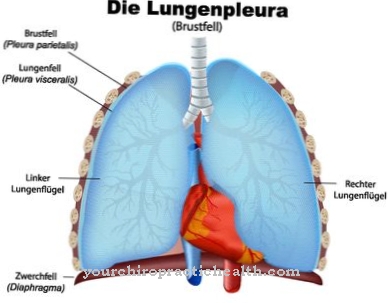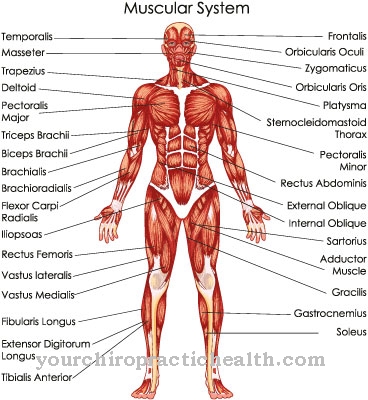Hyperventilation, hyperventilating, and rapid breathing are terms for breathing that has unnatural characteristics either in terms of frequency or depth of breath. An example of hyperventilation is unwarranted, excessive, and rapid breathing while at rest due to shock or excitement. Hyperventilation usually occurs in the course of seizures and can in turn cause other symptoms such as dizziness, visual disturbances, shortness of breath and chest pain. Sometimes it even leads to unconsciousness.
causes

Hyperventilation can occur in childhood. There is no gender-specific predisposition to hyperventilate.
Contrary to what one might assume, hyperventilation is mostly not physical but psychological. Above all, situations with psychological stress play a central role. Stress, fear and arousal are typical indicators. Hyperventilation occurs rather rarely as part of a neurological disease. Here, possible tumors can permanently disrupt the respiratory center in the brain.
If the hyperventilation is due to the disease, however, causes such as poisoning, oxygen deficiency, pulmonary embolism, heart failure and fever come into question and should be examined by a doctor.
You can find your medication here
➔ Medicines for calming & relaxationDiseases with this symptom
- Blood poisoning
- Fear of heights
- claustrophobia
- Heart failure
- Heart failure
- Pulmonary embolism
- Encephalitis
- poisoning
- Acidosis
- Anxiety disorder
- concussion
- Metabolic syndrome
course
It comes to one Hyperventilation, which usually involves rapid and deep breathing, the oxygen content in the blood is hardly increased, since saturation has already been made possible by normal breathing.
However, the proportion of carbon dioxide increases in its concentration much more when exhaled. The effect is then an increased pH value, which leads to respiratory alkalosis.
The result can then be muscle cramps, the so-called hyperventilation tetanus. This can lead to unconsciousness.
Complications
Hyperventilation is mostly of a psychogenic nature, i.e. it can only be explained in rare cases on the basis of a physical cause. On the one hand, complications concern, for example, that hyperventilation is somatized. Somatization describes the attribution of hyperventilation to a physical illness, although there is no physical finding.
The patient subconsciously manages to start a therapy that is not even necessary. Somatization occurs due to a psychosocial burden on the patient. Another complication is the chronification of hyperventilation. As more and more carbon dioxide is exhaled, the body loses acids in the blood. The pH of the blood increases. Respiratory alkalosis occurs.
In addition to chronic hyperventilation, acute hyperventilation can also cause respiratory alkalosis. Rapid breathing can put the body into a kind of trance state. In addition, the excitability of the muscle is increased, so that seizures can occur.
Typically the paw positions are the hands and arms. In addition, there is a contraction of the cerebral vessels, the brain receives less blood and dizziness occurs, which can lead to fainting. The risk of falling and injury is very high. Epileptic seizures can also occur. In addition, the brain can be seriously damaged.
When should you go to the doctor?
Hyperventilation is characterized by faster and deeper breathing than the body needs at the moment. It almost always has a psychological cause. In the case of hyperventilation, however, a possibly existing lack of oxygen should be considered, as well as other causes such as poisoning, pulmonary embolism or heart failure. If hyperventilation occurs, a doctor should therefore always be consulted to be on the safe side.
In the case of hyperventilation, the inhaled air that is currently not required is not simply exhaled again as excess. Rather, there is a concentration of carbon dioxide in the body with negative consequences such as muscle cramps or even loss of consciousness. If hyperventilation has already occurred several times, its occurrence must be clarified by a doctor. The first point of contact should be the family doctor.
He already knows his patient and can estimate well in advance whether a psychological background is likely or possibly a physical illness. Accordingly, he will issue a referral to the responsible specialist, for example a psychologist or psychotherapist, an internist, cardiologist or pulmonologist.
Doctors & therapists in your area
Treatment & Therapy
Not everyone with hyperventilation see a doctor immediately. However, if the seizures occur more often or are cause for concern, you should get examined. During the conversation, the doctor inquires about previous illnesses, medication taken and the situations in which hyperventilation has occurred. Most of the time, the causes of stress and arousal arise from this.
For differential diagnosis, the doctor may seek further examinations (electrocardiogram (EKG), x-rays, blood tests).
Once the cause has been identified, the appropriate therapy is selected. If stress and excitement are responsible for hyperventilation, the patient should be reassured. The prescription of autogenic training makes sense. In the case of an acute attack, one can also breathe into a plastic bag in order to normalize the carbon dioxide level again and to end the hyperventilation. In the event of cramps, sedatives (benzodiazepines) may be administered.
So-called breathing therapy should be used preventively and therapeutically, in which the patient can learn special breathing techniques. Furthermore, relaxation techniques such as progressive muscle relaxation, yoga or autogenic training should be used. If an anxiety disorder is the cause, additional psychotherapy should be considered. However, any psychotropic drugs used should only be considered as a last resort to recovery.
In the case of organic causes such as heart failure, blood poisoning or anemia, these diseases should be treated first.
Outlook & forecast
People who hyperventilate begin to breathe extremely in fearful situations. The breath becomes short and jerky, the frequency increases rapidly. Hyperventilation is not caused by an organic disease, but by psychological stress. Nevertheless, the unnatural breathing can increase to the point of fainting.
Because the muscles in the chest are very tense, hyperventilating people have the feeling that they can no longer breathe. The feeling of oppression creates panic and breathing becomes even more unnatural. So reassurance is very important. Once the tension is released, the symptoms will soon be gone.
However, if symptoms such as severe headaches, heart problems and the urge to urinate are added to hyperventilation, a doctor should be consulted. Then the disease could be chronic and physical.
Usually, hyperventilation is harmless and easy to treat. The most effective first aid measure is a plastic or paper bag into which the person must breathe in and out. After a few minutes the carbon dioxide accumulates in the blood and the pH value returns to normal. Breathing becomes normal. Those affected can also do something themselves: Concentrated diaphragmatic breathing quickly relieves the symptoms.
In 90% of cases, stress is the trigger, so the causes of stress should be eliminated. Relaxation exercises often help. In some cases, psychotherapy is useful. It teaches the sick person to deal better with stress.
You can find your medication here
➔ Medicines for calming & relaxationprevention
Non-pathological hyperventilation can be prevented by a healthy, stress-free life without unhealthy excitement with lots of exercise, fresh air, a healthy diet and refraining from smoking and alcohol. Autogenic training is also preventative, as it not only serves to calm you down, but can also bring more relaxation to everyday life.
You can do that yourself
In most cases, hyperventilation does not require calling a doctor. It is an unpleasant condition, but it can be treated with simple means. In any case, the main thing to do with hyperventilation is to calm down. Helpers, friends or acquaintances must speak to him well and instruct him to breathe more slowly and calmly. In most cases these instructions will help to overcome hyperventilation.
However, hyperventilation is often accompanied by fear and intense excitement. If this is the case, the patient has to breathe back into a vessel. This greatly increases the concentration of carbon dioxide in this vessel, so that this concentration also rises again in the blood and the patient's condition returns to normal. A bag or a breathing mask, for example, can be used as a vessel.
If hyperventilation does not stop with these remedies, a doctor should be consulted or called. They can also give sedatives to the affected person to stop the hyperventilation. In most cases, there are no other symptoms after the symptom.



























